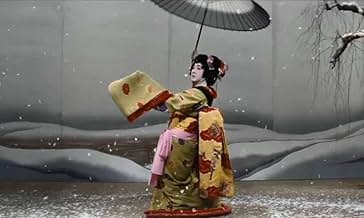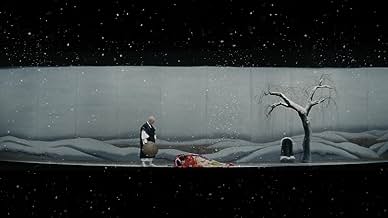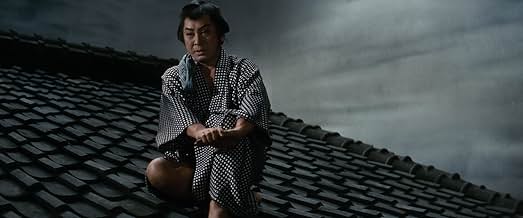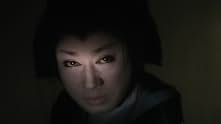Yukinojôs Rache - Von Dämonen verzauberte Schneemacht
Originaltitel: Yukinojô henge
IMDb-BEWERTUNG
7,3/10
3054
IHRE BEWERTUNG
Füge eine Handlung in deiner Sprache hinzuYukinojo, a Kabuki actor, seeks revenge by destroying the three men who caused the deaths of his parents. Also involved are the daughter of one of Yukinojo's targets, two master thieves, and... Alles lesenYukinojo, a Kabuki actor, seeks revenge by destroying the three men who caused the deaths of his parents. Also involved are the daughter of one of Yukinojo's targets, two master thieves, and a swordsman who himself is out to kill Yukinojo.Yukinojo, a Kabuki actor, seeks revenge by destroying the three men who caused the deaths of his parents. Also involved are the daughter of one of Yukinojo's targets, two master thieves, and a swordsman who himself is out to kill Yukinojo.
- Auszeichnungen
- 1 wins total
Empfohlene Bewertungen
I have seen several hundred Japanese films but am far from an expert on these movies. After all, I am not Japanese and don't always understand some of the subtleties in the pictures. For example, in "An Actor's Revenge", the main character (Yukinojo) is a man who performs as a woman on stage--that I knew and understood. However, he maintained this persona off-stage as well and I wondered just how unusual this was--did other male Kabuki actors also maintain this persona when they weren't acting? If you can answer this question, I would love to hear from you.
The film begins at a Kabuki performance. Yukinojo has recently come to Edo (Tokyo) and has been planning revenge on three scoundrels for many years. It seemed these wicked men were responsible for destroying his family and he sees himself as the instrument of revenge--much like the character in another famous Japanese film, "Lady Snowblood". However, he doesn't want to just stab them--he wants to have them linger and give him a chance to revel in their destruction. Part of it, however, depends on using the daughter of one of these wicked men--and the lady is innocent of causing any harm to anyone. What's Yukinojo to do? And, what is he to do when several ancillary characters blunder or wander into his plans?
There were several things I liked about the film. First, the various thieves who were no necessary to the film helped to give the film greater depth and, in an odd way, fun. Second, the film was made in many ways like the entire production was ALL part of a play. Often, using interesting lighting and sets, it looked as if the line between the off-stage and on-stage was often blurred. It made the film truly memorable. Overall, well worth seeing and gloriously artistic.
The film begins at a Kabuki performance. Yukinojo has recently come to Edo (Tokyo) and has been planning revenge on three scoundrels for many years. It seemed these wicked men were responsible for destroying his family and he sees himself as the instrument of revenge--much like the character in another famous Japanese film, "Lady Snowblood". However, he doesn't want to just stab them--he wants to have them linger and give him a chance to revel in their destruction. Part of it, however, depends on using the daughter of one of these wicked men--and the lady is innocent of causing any harm to anyone. What's Yukinojo to do? And, what is he to do when several ancillary characters blunder or wander into his plans?
There were several things I liked about the film. First, the various thieves who were no necessary to the film helped to give the film greater depth and, in an odd way, fun. Second, the film was made in many ways like the entire production was ALL part of a play. Often, using interesting lighting and sets, it looked as if the line between the off-stage and on-stage was often blurred. It made the film truly memorable. Overall, well worth seeing and gloriously artistic.
Yukinojo Henge, or "An Actors Revenge" in English can be appreciated on a number of different levels. First of all there is the intricate plans of revenge the kabuki actor main character carries out against those who had been responsible for his parents deaths. Secondly one can enjoy it as a period piece. Those interested in Tokugawa Period Japan will enjoy critiquing the historical accuracy of the film. However what really separates this movie from other tales of revenge and intrigue is in its playfulness.
The movie was considered a tribute to the actor who played the part of the lead. It was Kazuo Hasegawa's 300th role and the movie was a remake of the 1935 film of the same name. In many scenes you can see Hasegawa injecting himself as an actor into the movie. These can usually be picked up only if one is somewhat familiar with the behind the scenes aspects of the film. If one is aware that Hasegawa is not only playing the main character, but also that of Yamitaro the thief then there are certain parts of the dialogue that take on a new meaning.
One example of this is when Hasegawa playing the thief witnesses Hasegawa playing Yukinojo Nakamura lying to his love interest and pawn Namiji. After seeing this Yamitaro comments to himself, and also to the audience, that Nakamura is such a great actor, referring to his lies, that he shouldn't be wasting his time with his kabuki troop. Since we as viewers are aware that we are seeing a movie, as well as being aware that the one being commented on is the same as the one doing the commenting, we can see this as Hasegawa making his presence as the actor Hasegawa known. He is essentially complimenting himself saying, "I am such a great actor, why am I wasting my time doing this movie?" There are a couple more instances of similar playfulness between the three part relationship of Hasegawa as Hasegawa the actor in the reality of the film audience, Hasegawa as Nakamura the actor in the reality of the characters, and Hasegawa as Yamitaro. In one scene Yamitaro explains that the reason he is aiding Nakamura in his quest is because he has come to feel a kinship with him as if he were his brother, again playing on the audience's knowledge that the two "brothers" are played by the same person.
Another example of how playful the film is can be seen in its cinematography. The main character is a kabuki onnagata, or a male actor who specializes in playing female roles. There are a couple of scenes in the movie that play up on this fact and shoot the movie in a fashion that provides the audience with the feeling that they are watching a kabuki play. In one example there is a swordfight in a forest. Even though the movie is made in the 1960s when it would have been very possible to have realistic looking backgrounds, the trees do not look real at all. This makes the forest in which they are fighting feel more like a theater set than an authentic landscape. During this swordfight an onlooker says to herself that it is better than watching one on a kabuki stage. Since the audience is aware of the fake scenery, the characters role as an onnagata, and some would even know that the actor himself was once an onnagata, the comment takes on a whole new life than were it an onlooker in a basic action movie watching a scene and saying, "wow that was even cooler than in the movies!" With all of these inside jokes between the actors and the film audience that the characters are not aware of, the movie becomes much more interactive and thus more enjoyable for someone looking for a fun multi-layered movie.
The movie was considered a tribute to the actor who played the part of the lead. It was Kazuo Hasegawa's 300th role and the movie was a remake of the 1935 film of the same name. In many scenes you can see Hasegawa injecting himself as an actor into the movie. These can usually be picked up only if one is somewhat familiar with the behind the scenes aspects of the film. If one is aware that Hasegawa is not only playing the main character, but also that of Yamitaro the thief then there are certain parts of the dialogue that take on a new meaning.
One example of this is when Hasegawa playing the thief witnesses Hasegawa playing Yukinojo Nakamura lying to his love interest and pawn Namiji. After seeing this Yamitaro comments to himself, and also to the audience, that Nakamura is such a great actor, referring to his lies, that he shouldn't be wasting his time with his kabuki troop. Since we as viewers are aware that we are seeing a movie, as well as being aware that the one being commented on is the same as the one doing the commenting, we can see this as Hasegawa making his presence as the actor Hasegawa known. He is essentially complimenting himself saying, "I am such a great actor, why am I wasting my time doing this movie?" There are a couple more instances of similar playfulness between the three part relationship of Hasegawa as Hasegawa the actor in the reality of the film audience, Hasegawa as Nakamura the actor in the reality of the characters, and Hasegawa as Yamitaro. In one scene Yamitaro explains that the reason he is aiding Nakamura in his quest is because he has come to feel a kinship with him as if he were his brother, again playing on the audience's knowledge that the two "brothers" are played by the same person.
Another example of how playful the film is can be seen in its cinematography. The main character is a kabuki onnagata, or a male actor who specializes in playing female roles. There are a couple of scenes in the movie that play up on this fact and shoot the movie in a fashion that provides the audience with the feeling that they are watching a kabuki play. In one example there is a swordfight in a forest. Even though the movie is made in the 1960s when it would have been very possible to have realistic looking backgrounds, the trees do not look real at all. This makes the forest in which they are fighting feel more like a theater set than an authentic landscape. During this swordfight an onlooker says to herself that it is better than watching one on a kabuki stage. Since the audience is aware of the fake scenery, the characters role as an onnagata, and some would even know that the actor himself was once an onnagata, the comment takes on a whole new life than were it an onlooker in a basic action movie watching a scene and saying, "wow that was even cooler than in the movies!" With all of these inside jokes between the actors and the film audience that the characters are not aware of, the movie becomes much more interactive and thus more enjoyable for someone looking for a fun multi-layered movie.
This is an Ichikawa film so expect anything short of sheer visual awesomeness and yer a fool. Impeccably staged, superbly lighted and shot with remarkable flair for atmosphere, this one deserves a watch on its technical cinematic merits alone. The plot relates the adventures of a Kabuki stage actor plotting revenge against those who disgraced and drove his parents to madness and suicide, apparently a readaptation of a 30's movie. Everything is very campy though and the protagonist, a feminine man with a pathetic croaky voice dressed in woman's clothes, is bound to induce a fair amount of groans. Obviously related to the material at hand, Ichikawa stages and shoots the movie in a stylized theatrical manner. The intentional artificiality of sets and lighting perfectly mirrors that. Perhaps the best thing about it is the use of colour, with bright reds, yellows and whites offering a vibrant counterbalance to the almost complete darkness of other set-pieces. All in all, I didn't find the dramaturgy of the film very involving and I suspect Ichikawa didn't care for it either. From a technical standpoint however it is certainly commendable.
This movie is that rare species - a film that doesn't take itself seriously for a moment, and yet is stunningly well made and original.
According to Donald Richies '100 Years of Japanese Cinema' the director was forced to make this movie (the remake of a popular but very hammy 1930's original) as a punishment for his self indulgence in earlier movies. He responded by turning up the campiness to '11' in Spinal Tap terms.
Kon Ichikawa manages to take the story of a famous Kabuki female impersonator who wrecks revenge on three powerful men who killed his parents both beautiful (the scenery and photography is stunning) and queasy - everyone seems to fall in love with the rather ugly and very feminine leading 'man'. The story is irrelevant (presumably deliberately so), its all an exercise in style. You can see where Suzuki and many other later directors got a lot of their ideas. Kon is a very talented and skillful film maker so despite the fact that the cast are clearly playing it up for laughs, it is extremely well made, with wonderful sets and tight editing. Despite its origins, it is genuinely entertaining and required viewing for anyone with an interest in Kabuki or Japanese design.
According to Donald Richies '100 Years of Japanese Cinema' the director was forced to make this movie (the remake of a popular but very hammy 1930's original) as a punishment for his self indulgence in earlier movies. He responded by turning up the campiness to '11' in Spinal Tap terms.
Kon Ichikawa manages to take the story of a famous Kabuki female impersonator who wrecks revenge on three powerful men who killed his parents both beautiful (the scenery and photography is stunning) and queasy - everyone seems to fall in love with the rather ugly and very feminine leading 'man'. The story is irrelevant (presumably deliberately so), its all an exercise in style. You can see where Suzuki and many other later directors got a lot of their ideas. Kon is a very talented and skillful film maker so despite the fact that the cast are clearly playing it up for laughs, it is extremely well made, with wonderful sets and tight editing. Despite its origins, it is genuinely entertaining and required viewing for anyone with an interest in Kabuki or Japanese design.
There are some truly beautiful scenes here, particularly the marvellous use of widescreen in the colourful kabuki sequences and Kazuoha Segawa is faultless in the duel central role. He plays dressed as a woman on the stage but seems also to live out his life this way and he also plays his thieving side-kick. Apparently played for laughs throughout it is difficult for a non Japanese to fully appreciate much of the subtlety and Shakespearean style play on words. Indeed, for me, the whole is rather too mannered and stagey. There is much blurring between stage and 'real life' which some find charming but I tend to find rather confusing and lifeless.
Wusstest du schon
- WissenswertesOriginally designed as a tribute to actor Kazuo Hasegawa, whose 300th film this was. The film was based Teinosuke Kinugasa's Yukinojô henge: Daiippen (1935) which also starred Hasegawa in the same dual role.
- VerbindungenVersion of Yukinojô henge: Daiippen (1935)
Top-Auswahl
Melde dich zum Bewerten an und greife auf die Watchlist für personalisierte Empfehlungen zu.
- How long is An Actor's Revenge?Powered by Alexa
Details
- Erscheinungsdatum
- Herkunftsland
- Sprache
- Auch bekannt als
- An Actor's Revenge
- Produktionsfirma
- Weitere beteiligte Unternehmen bei IMDbPro anzeigen
- Laufzeit1 Stunde 55 Minuten
- Sound-Mix
- Seitenverhältnis
- 2.35 : 1
Zu dieser Seite beitragen
Bearbeitung vorschlagen oder fehlenden Inhalt hinzufügen

Oberste Lücke
By what name was Yukinojôs Rache - Von Dämonen verzauberte Schneemacht (1963) officially released in India in English?
Antwort





























